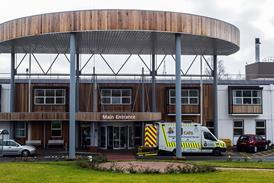Same-day emergency care demands a shift in mindset from A&E staff comparable to that required by day surgery.
But it has now been boosted by new best practice tariffs for 12 emergency clinical scenarios which can be treated on the same day. So how will these tariffs work in practice? And what else do you need to know to make this approach work?
What is ambulatory emergency care?
Ambulatory emergency care or same-day emergency care is achieved by creating a whole system approach across primary and secondary care. This ensures that, where appropriate, patients are diagnosed and treated on the same day and then sent home with ongoing clinical supervision as needed. If implemented successfully, this approach has the potential to both improve patient experience and reduce costs.
Ian Smith, the president of the British Association of Day Surgery says: “Ambulatory emergency care shares many parallels with day surgery, which has experienced enormous growth, achieved predominantly by changes in mindset and simple alterations to the patient pathway, resulting in safer, higher-quality care.”
In 2007, the NHS Institute for Innovation and Improvement created the Directory of Ambulatory Emergency Care which outlines 49 emergency conditions and clinical scenarios which could be suitable for ambulatory treatment. An Ambulatory Emergency Care Delivery Network has also been set up to support trusts who want to implement the approach. A national team of clinical and improvement experts are leading an improvement programme made up of workshops, virtual visits, webinars, and individual support for 11 participating health communities.
One of the critical success factors for AEC is a cohesive approach across health and social care. Therefore, the participating systems have input from clinicians, managers and analysts, from both secondary care and community services, as well as the commissioners, GPs, and clinical commissioners working together to design the services.
Pioneers of ambulatory emergency care have achieved good results, with growing evidence of the impact. For example, Weston Area Health Trust, which began developing AEC in 2006, now has 100 fewer beds than in 2009 because the approach has reduced emergency admissions.
Deborah Thompson, associate director at Weston, says: “Judging by some of the work going on at the moment within the network, I think we are looking at a future state where people might wonder how they ever coped with what went before. Major changes like the introduction of day surgery can seem radical, almost unthinkable, at the time. However, as organisations begin to tackle the issue and overcome the challenges, a radical change becomes the norm, and its introduction helps to transform the experience of patients and staff.”
The new tariffs
In April, the Department of Health introduced new best practice tariffs for 12 conditions to promote ambulatory emergency care. The conditions are:
- Cellulitis
- Pulmonary embolism
- Asthma
- Acute headache
- Chest pain
- Lower respiratory tract infections without chronic obstructive pulmonary disease
- Appendicular fractures not requiring immediate fixation
- Renal/ureteric stones
- Falls including syncope and collapse
- Epileptic seizure
- Deliberate self-harm
- Deep vein thrombosis.
The move has been welcomed as trusts are effectively penalised for short length of stay, receiving only a fraction of the tariff. The new tariff applies to only 12 of the potential 49 conditions and scenarios listed in the NHS Institute’s directory so its impact will be limited, but it is a significant move in the right direction. A phased approach will also allow any anomalies to be addressed. More conditions are expected to be added in future.
However, there is scope for confusion. For example, there are two prices for each clinical scenario. One is for emergency admissions with a zero-day length of stay, while the other is for a one-day length of stay. The latter isn’t strictly ambulatory emergency care, as managing patients in an ambulatory way means avoiding an overnight stay altogether.
There is also concern the new tariff could jeopardise existing local tariff agreements that have been previously made between trusts and commissioners. The DoH has responded by giving organisations the option to retain these local arrangements.
Realising the full potential of AEC
In the last few years, pioneers of ambulatory emergency care have succeeded in applying ambulatory emergency care to an ever-increasing range of clinical conditions and scenarios, beyond those listed in the original NHS Institute Directory. As a result, the AEC Delivery Network has changed its guidance. Once it would have advised starting small, but now it recommends being more ambitious as this is the best way to realise the full potential of the approach.
Many organisations who have successfully developed AEC take an exclusion approach, specifying which types of patients they will not treat in an ambulatory way, rather than those they will. These trusts found that specifying who was eligible limited the impact. Leaving this open allows colleagues to refer patients who could be appropriately managed in an ambulatory way, but do not fall within the conditions recommended in the directory.
Unintended consequences
Some people have expressed concern that the new best practice tariffs might lead to patients being inappropriately discharged, or treated in an ambulatory setting when they should be admitted to hospital. The AEC Delivery Network has not experienced this and believes it is an unlikely outcome.
A passion to improve the quality of emergency care for patients has been the driving force behind the development of AEC so far. Although it is estimated that there could be considerable financial and productivity gains to be had in rolling out AEC, quality must be the main driver if we are to deliver an excellent patient experience.
Coding non-tariff emergency care
Coders need to make sure patients’ medical records accurately capture their treatment and that the correct code is ascribed to it. Now they will face the challenge of coding non-tariff ambulatory emergency care treatment. But even where the tariff does apply, coding can be tricky. Take pulmonary embolism for example: for each confirmed diagnosis, four patients will be suspected of pulmonary embolism but their final diagnosis will be different. How will the process of eliminating these other conditions be reimbursed? This situation is typical of many emergency situations where patients present with a constellation of signs and symptoms which require intervention but could have various final diagnoses.
What do organisations need to do?
Despite these concerns, the AEC Delivery Network is positive about the introduction of the new best practice tariff. Our general consensus is that the new tariff will incentivise trusts to treat patients in an ambulatory way, and that any unintended consequences will not be as significant as some people fear.
For trusts who are preparing for the new tariff it is important that they develop an approach that suits their local circumstances and their populations’ needs. There is no ‘one-size fits all’ approach. It is helpful to regard ambulatory emergency care as a process rather than simply creating a pathway for the number of conditions specified by the DH, as this approach has been shown to deliver greater benefits in the long term.
As with any change, effective leadership, understanding how your patients experience your existing services, and involving your staff in designing the best service for your circumstances are key. In addition, organisations who take a health and social care system-wide approach to implementing AEC achieve the best outcomes - and we have certainly seen great examples from the network.
Carolyn Robertson, programme lead for NHS Institute Ambulatory Emergency Care delivery network; Dr Vincent Connolly, chief of service, acute medicine, James Cook University Hospital; Deborah Thompson, associate director for service development, Weston Area Health Trust.
Find out more
For further information about the AEC Delivery Network please email emergencycare@institute.nhs.uk or visit the website
























No comments yet